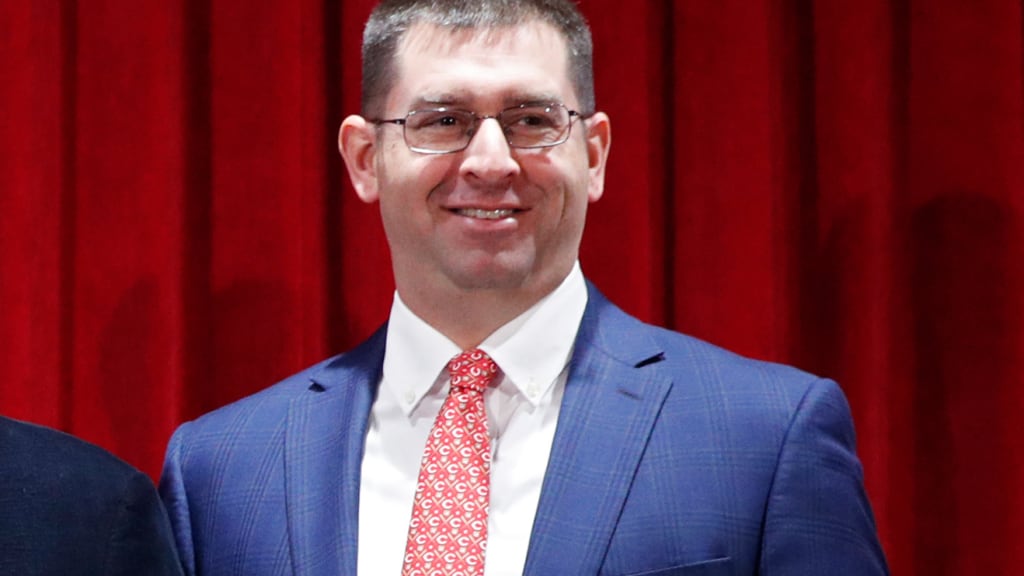
CINCINNATI -- Now that the non-tender deadline came and went on Wednesday, it's possible that the so-far quiet offseason could begin percolating with more transactions now that teams have a better idea of what the free agent and trade market will look like.
With that in mind, here are three things I've been thinking about regarding the Reds.
1. Wednesday's non-tenders showed that the budget is tight.
The Reds released five players -- and brought one back -- on Wednesday at the non-tender deadline. While the moves weren't earth-shattering, they were telling. It shows just how little wiggle room there is in the budget for general manager Nick Krall after a 2020 season where the entire baseball industry was hit hard economically by the pandemic.
Krall let two players go the club just acquired in trades on Aug. 31 -- reliever Archie Bradley and outfielder Brian Goodwin. With a crowded outfield already, Goodwin was caught in a numbers game and was an easy place to save some money. But Bradley could have been a big plus in the late innings -- either as a closer or setup man. But a raise from his $4.1 million prorated salary in 2019 would have been too much of a luxury item in the current economic environment.
"I think we'll have some room to do some things," Krall said. "We're just working through right now to trim up where we are and just be more efficient."
Without Bradley, the Reds' bullpen still has closer Raisel Iglesias, lefty Amir Garrett, right-hander Lucas Sims and possibly Michael Lorenzen -- if he doesn't move into the rotation. Krall did not rule out the idea that Bradley could still be brought back.
It was a boost for the bench when the Reds re-signed non-tendered player Kyle Farmer. Not only is he versatile and able to play every infield spot and catcher, he's become very well liked in the clubhouse and adds to the chemistry of the group.
2. Sonny Gray rumors
Last week, MLB Network insider Ken Rosenthal reported that the Reds were listening to trade offers for starting pitcher Sonny Gray. It caught some people -- including me -- by surprise, because Cincinnati's rotation could lose Trevor Bauer and Anthony DeSclafani as free agents and 2021 is viewed as a year to contend, not rebuild.
When I filled in as co-host on the Reds Hot Stove League radio show last week, I asked Krall about the Gray rumors. He downplayed its significance.
"We've had multiple conversations with every team, agents for free agents, all that stuff, and you're just trying to figure out what is out there, how can you make your team the best," Krall said. "We've had hits on just about every player on our roster. Some guys have had 15 hits from different clubs and people ask about it. You're going to ask about it because you want to know, at least, who is available, who is not available and what the landscape of that market looks like.
"Whether you're doing something or not is a whole different ballgame. I think that's where we have to take a step back and look at this and say, 'OK, let's see what is available, let's see what is not available and then let's figure out what makes the most sense for our team moving forward.'"
Krall and former baseball operations president Dick Williams have long maintained there are no "untouchable" players. But, obviously, there are levels of seriousness. There's no harm in listening and I don't expect Gray to go anywhere.
Besides having a 3.07 ERA over 42 starts in two seasons for the Reds, Gray has two years and over $20 million left on his contract. He's also emerged as a clubhouse leader. That's been good value for Cincinnati and all reasons why he will stay.
3. Jagers to crunch pitching numbers
It's not often that a coach joins a staff who is younger than most of the players, but that's the situation for Eric Jagers. At only 25, Jagers was promoted on Tuesday to assistant pitching coach after one season as assistant pitching coordinator.
Like his predecessor Caleb Cotham, Jagers' hiring was for the analytical side and data crunching under pitching coach Derek Johnson, and the skills he acquired while working for Driveline Baseball. But unlike Cotham, Jagers has never pitched professionally after injuries ended his career with the University of Iowa.
"Caleb was a Major League pitcher that was also very understanding of the data-driven approach, but I do think that when Caleb did get this job, he didn't really have much coaching experience, where Eric does," Krall said on Wednesday. "That's a little different, he'll come with a little bit different angle, but I do think that Eric has the growth ahead of him, but he also has a really good understanding of what we need to do from that position just like Caleb did when he came in.
"I think when Caleb came in, he had a lot to learn especially from a coaching standpoint but had a big league pedigree. I think that Eric comes in with a very similar background but with more coaching experience and more experience working with numbers and being able to learn at the big league level what he didn't know. I think they're very comparable to when Caleb first started."


